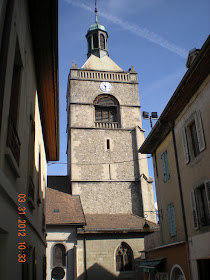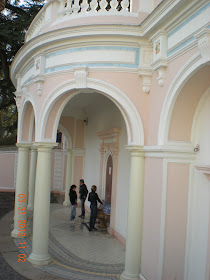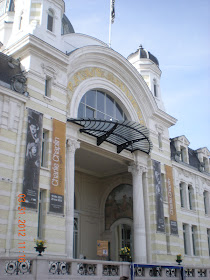It is finally springtime in Switzerland! We have always been curious about the little towns that dot the coastline opposite from us on Lake Geneva-the French side of the lake towns. Saturday was such a beautiful and sunny day the we decided to take the boat from Lausanne/Ouchy to Evian, and spend the day site seeing.
The shore line of Evian. It is about a 35 minute boat ride from Ouchy.
Evian with a population of 8,000+ is located in southeastern France, across Lake Geneva (French: Lac Leman) from Lausanne, Switzerland. In addition to its international reputation for its Evian Water, it is also known world wide as an elite resort area with thermal spas. In 1865 the town officially changed its name to Evian-les-Bains (Evian Baths). We will talk more about Evian water, which made the city famous, later in the blog.
As always, when we visit a city for the first time, we head straight for the tourist information center to get maps of the area. Also, the TI folks are always so helpful to make sure that we don't miss any important sites. The folks at the Evian TI were no exception, they provided us with a lot of useful information.
We started our visit at: Notre-Dame de l'Assomption. Every town has a church they are proud of and Evian is no exception.
The stained glass window behind the alter.
The Rosary Chapel. In the chapel is this bas relief of the Virgin and Child made out of polychrome wood from the late 15th century.
The Market Square. Situated in the center of the city, this square has been where commercial activities have taken place since the Middle Ages. Clearly a slow day in the market.
The boatman of Evian, who in 1399 were granted a transport monopoly on Lake Geneva, would unload their goods on the shore at the lower end of the square. The harbor became an essential port of call for merchants sailing to the large fairs in Geneva and Lyon.
At the end of the 13th century, not only were local products bought and sold in the square, but also more exotic goods such as fabrics, mirrors and other luxury goods offered by the Lombard merchants.
For nearly 700 years, every Monday was market day and the square came to life. Today they hold their market every Friday. Now Jim will have to go back on a Friday and report!
A picture down one of the Evian side street.

The Cachat Pump Room. This pump room built in 1903 was used to pump water from the Cachat spring. Designed as a "water temple", this pavilion of wood and glass is toped by a cupola of glazed tiles and lit by large semicircular stained glass windows. The large area in the front of the building is where they used to hold morning concerts.
The controls for the pump room were on the ground floor. On the first floor was the center for social life, with reading and lounge rooms. There was a large fountain in the center of the room.
In 1956 the pump room was replaced by a building near the Evian harbor.
This beautiful structure encloses the Cachat Spring.
Evian's source is the Cachat spring where the water emerges from a tunnel, originating in the Mont Blanc area which towers above the town of Evian, at a constant 52.88 degrees F., summer or winter.
The source is fed from the snow-melt and rain that filters through the glacial sands of Mont Blanc. The glacial sand is surrounded by clay which protects the water from pollution. According to the Evian Bottling Company, it takes about 15 years for the water to reach Evian. The water is then bottled at a plant which is highly automated and exceptionally hygienic. The plant is located in Amphion, about 3 miles from the town of Evian.
A French women getting water from the Cachat spring. This spring flows every day. The locals are lined up at various spigots with their empty vessels ready to haul it home.
There are three other springs from which Evian water flows: Bonnevie, Clemont and Cordeliers. The Cordeliers spring is located about a 100 yards from the Cachat spring. We tasted water from each spring and quite frankly it did not taste much different from the water we drink in Vevey.
The discovery of Evian's mineral water dates back to 1790, when, during a walk, a nobleman from Auvergne, the Count of Laizer, refreshed himself at the Fountain of Saint Catherine on the estate of one Monsieur Cachat.
Finding this water healthy, "light and freely flowing", this man, who suffered from pain in his liver and kidneys and had begun to drink regularly from the fountain during his walks, began to notice a marked improvement in his health. He afterwards praised the "miraculous" qualities of this water, which began to be prescribed by doctors.
This immediate success led Monsieur Cachat to close off the spring and begin selling its water. In 1826, Francois Fauconnet, a Genevan businessman, founded the first "Evian Baths".
In 1824,the King of Sardinia, granted permission for its bottling. In 1869, the Mineral Water Company of Evian-les-Bains was established.
Today, mineral water is the basis for Evian's international reputation.
Someone asked us what it tasted like. Upon reflection we said, "It tastes FREE."
Someone asked us what it tasted like. Upon reflection we said, "It tastes FREE."
The crew we traveled with-from the left Chandru, Paula, Jim, Ash and Cynthia.
This is a memorial dedicated to the French soldiers who fought in WW1, WW2 and the French-Indo China Wars
The Palais Lumiere (The Palace of Lights) built in 1902.
The yellow and white facade is made of glazed bricks and stones. From 1902 until 1984 the building was used as a center for social life and a huge spa - it could handle over 1,200 spa treatments at a time. After the building closed in 1984 it slowly began to deteriorate. The city took possession and after extensive renovation, it reopened in 2006 as the city's Cultural Center and exhibit hall.
Currently, there is a large exhibit of the work of Charlie Chaplin (London-April 16,1889 - Vevey-December 25,1977). This exhibition, made possible by the personal archives of the Chaplin family, tells the beginnings of Charlie, the evolution of a comic, his commitments of mixing professional and private lives.
Photographs, on loan from the Lausanne Museum, film clips, posters and newspaper clippings tells the life story of this actor and filmmaker genius.
During the era of McCarthyism, J. Edgar Hoover accused Chaplin of “un-American activities” as a suspected communist. He had instructed the FBI to keep extensive secret files on him and tried to end his United States residency.
In 1952, Chaplin left the US for what was intended as a brief trip home to the United Kingdom for the London premiere of one of his movies, Limelight. Hoover learned of the trip and negotiated with the Immigration and Naturalization Service to revoke Chaplin's re-entry permit. Chaplin decided not to re-enter the United States and gave up his residence in the United States.
In 1952 he and his family moved to Vevey, Switzerland, where he died on Dec. 25, 1977. Chaplin was buried in Corsier-Sur-Vevey Cemetery. On March 1, 1978 his corpse was stolen by a small group of Swiss mechanics in an attempt to extort money from his family. The plot failed; the robbers were captured, and the corpse was recovered eleven weeks later near Lake Geneva. His body was reburied under 6 feet of concrete to prevent further attempts.
One of the stain glassed windows in The Palais Lumiere.
In The Palais Lumiere is a large hall that has statues in all 4 corners. The statues represent the 4 springs in Evian; Cachat, Bonnevie, Clemont and Cordeliers. The water flows continuously into red basins.
This statue represents Cachat Springs.
This statue represents Cordeliers Springs.
Jardin de Neckargemund – Gardens of Neckargemund.
These gardens are located in front of The Palais Lumiere. The gardens are named after the German city of Neckargemund, which is Evian's sister city. About 5 miles from Heidelberg, Neckargemund is a charming little town situated on the shore of the river Neckar. The name of this beautiful little town comes from the German Mund, i.e. mouth, because this is where the "mouth" of the river Elsenz joins the river Neckar.
The gardens have nice lawns, trees, shrubs, lots of roses and plenty of seating. Just across the road is Lake Geneva.
The gardens have nice lawns, trees, shrubs, lots of roses and plenty of seating. Just across the road is Lake Geneva.
Villa Lumiere - aka Hotel De Ville.
In 1896 photographer Antoine Lumiere acquired the villa as his summer residence. In 1895 his sons Louis and Auguste invented the cinematograph. Their work can be seen in the Museum of Lumiere at Lyon.
In 1927 it became the Evian Town Hall. Inside, is the gilded drawing room, also known as the "Salon Dore or "Golden Lounge", a room with yellow silk curtain's and golden panelling, this is the lovely area where marriage's are now celebrated.
One of the many restaurants in Evian.
The walk way along the Evian waterfront.
People enjoying the sunny day along the waterfront.
Paula and Jim enjoying the waterfront prior to heading back to Vevey. And who says there's nothing to do in Evian!




























No comments:
Post a Comment